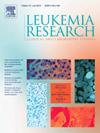Germline genetic variants that predispose to myeloproliferative neoplasms and hereditary myeloproliferative phenotypes
IF 2.1
4区 医学
Q3 HEMATOLOGY
引用次数: 0
Abstract
Epidemiological evidence of familial predispositions to myeloid malignancies and myeloproliferative neoplasms (MPN) has long been recognised, but recent studies have added to knowledge of specific germline variants in multiple genes that contribute to the familial risk. These variants may be common risk alleles in the general population but have low penetrance and cause sporadic MPN, such as the JAK2 46/1 haplotype, the variant most strongly associated with MPN. Association studies are increasingly identifying other MPN susceptibility genes such as TERT, MECOM, and SH2B3, while some common variants in DDX41 and RUNX1 appear to lead to a spectrum of myeloid malignancies. RBBP6 and ATM variants have been identified in familial MPN clusters and very rare germline variants such as chromosome 14q duplication cause hereditary MPN with high penetrance. Rarely, there are hereditary non-malignant diseases with an MPN-like phenotype. Knowledge of those genes and germline genetic changes which lead to MPN or diseases that mimic MPN helps to improve accuracy of diagnosis, aids with counselling regarding familial risk, and may contribute to clinical decision-making. Large scale population exome and genome sequencing studies will improve our knowledge of both common and rare germline genetic contributions to MPN.
易患骨髓增生性肿瘤和遗传性骨髓增生性表型的基因变异
髓系恶性肿瘤和骨髓增生性肿瘤(MPN)的家族易感性的流行病学证据早已得到公认,但最近的研究增加了对导致家族风险的多个基因中特定种系变异的了解。这些变体可能是普通人群中常见的风险等位基因,但其渗透率较低,会导致散发性 MPN,如 JAK2 46/1 单倍型,它是与 MPN 关系最密切的变体。越来越多的关联研究发现了其他 MPN 易感基因,如 TERT、MECOM 和 SH2B3,而 DDX41 和 RUNX1 的一些常见变异似乎会导致一系列髓系恶性肿瘤。在家族性骨髓增生性恶性肿瘤群中发现了RBBP6和ATM变体,而非常罕见的种系变体(如染色体14q重复)会导致高渗透性的遗传性骨髓增生性恶性肿瘤。极少数遗传性非恶性疾病具有类似 MPN 的表型。了解导致多发性骨髓瘤或类似多发性骨髓瘤的疾病的基因和种系遗传变化有助于提高诊断的准确性,帮助提供有关家族风险的咨询,并有助于临床决策。大规模的人群外显子组和基因组测序研究将提高我们对常见和罕见种系遗传对多发性骨髓瘤影响的认识。
本文章由计算机程序翻译,如有差异,请以英文原文为准。
求助全文
约1分钟内获得全文
求助全文
来源期刊

Leukemia research
医学-血液学
CiteScore
4.00
自引率
3.70%
发文量
259
审稿时长
1 months
期刊介绍:
Leukemia Research an international journal which brings comprehensive and current information to all health care professionals involved in basic and applied clinical research in hematological malignancies. The editors encourage the submission of articles relevant to hematological malignancies. The Journal scope includes reporting studies of cellular and molecular biology, genetics, immunology, epidemiology, clinical evaluation, and therapy of these diseases.
 求助内容:
求助内容: 应助结果提醒方式:
应助结果提醒方式:


